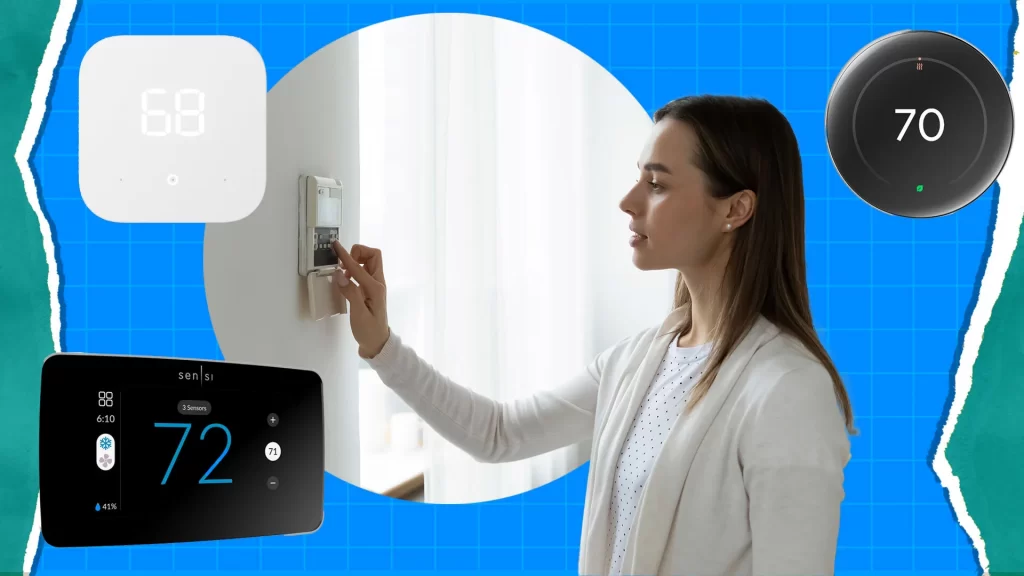Save energy, increase comfort, and take full control of your home’s climate — smarter than ever in 2025.

🌟 Why You Need a Smart Thermostat in 2025
In the ever-evolving world of smart homes, smart thermostats have become essential. They’re not just about adjusting temperature remotely — they learn your habits, save you money, and reduce your carbon footprint. With rising energy costs and growing environmental awareness, upgrading to a smart thermostat is one of the most effective investments you can make for your home.
In this guide, we compare the top 5 smart thermostats of 2025, highlighting their unique features, pros and cons, and which one might be the perfect match for your lifestyle.
🥇 1. Google Nest Learning Thermostat (3rd Gen)
Key Features:
- Learns your schedule and preferences
- Auto-schedule and energy reports
- Google Assistant integration
Pros:
- Sleek, minimalist design
- Reliable learning algorithm
- High resale and brand value
Cons:
- Premium price
- Limited support for multi-zone control
Best for: Users who want a stylish, intelligent device that does the thinking for them.
🥈 2. Ecobee Smart Thermostat Premium
Key Features:
- Built-in Alexa & Siri
- Comes with room sensors
- Indoor air quality monitoring
Pros:
- Voice control out of the box
- Multi-room temperature precision
- Smart speaker functionality
Cons:
- Setup can be tricky
- Requires occasional firmware updates
Best for: Smart home enthusiasts who want full voice control and advanced customization.
🥉 3. Tado° Smart Thermostat V3+
Key Features:
- Geofencing-based control
- Open window detection
- Works well in European HVAC systems
Pros:
- Intuitive mobile app
- Energy usage analytics
- Affordable price point
Cons:
- Some features require subscription
- Not fully compatible with all voice assistants
Best for: European users and budget-conscious buyers looking for great value.
🔧 4. Honeywell Home T9 Smart Thermostat
Key Features:
- Smart room sensors
- Supports Alexa, Google Assistant, and SmartThings
- Large color touchscreen
Pros:
- Easy to use
- Affordable alternative
- Accurate room-by-room control
Cons:
- App interface needs a refresh
- Limited learning capabilities
Best for: Families and renters wanting better control without breaking the bank.
🇩🇪 5. Bosch Smart Thermostat II
Key Features:
- Elegant design
- Modular configuration
- Strong integration with Bosch ecosystem
Pros:
- Durable build quality
- Excellent in European climates
- Easy to install and configure
Cons:
- Limited smart features compared to competitors
- Smaller user community/support
Best for: Bosch product owners and fans of German engineering.
📊 Comparison Table
| Thermostat | Price | Voice Assistant | Room Sensors | Learning Feature |
|---|---|---|---|---|
| Nest 3rd Gen | $$$ | ❌ | ✅ | |
| Ecobee Premium | $$$$ | ✅ Alexa/Siri | ✅ | ✅ |
| Tado° V3+ | $$ | ❌ (partial) | ❌ | ✅ |
| Honeywell T9 | $$ | ✅ All major | ✅ | ❌ |
| Bosch Smart II | $$ | ❌ | ❌ | ❌ |
🧠 Final Thoughts: Which Smart Thermostat Should You Buy in 2025?
If you’re seeking the best learning AI and polished design, the Google Nest is still a top-tier choice. For those wanting more control, Ecobee offers an incredibly flexible setup. On a tighter budget? Tado° or Honeywell T9 give you excellent performance without overspending.
No matter your choice, all of these options can help you cut down your energy bills, boost comfort, and future-proof your home.
